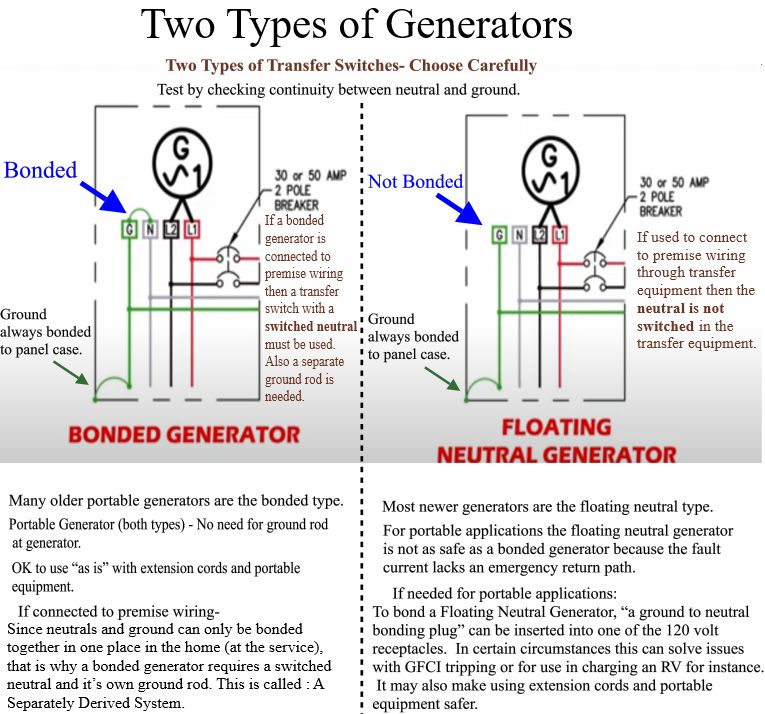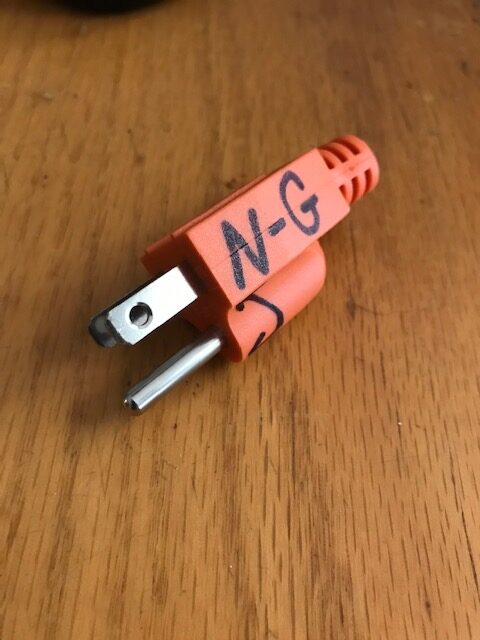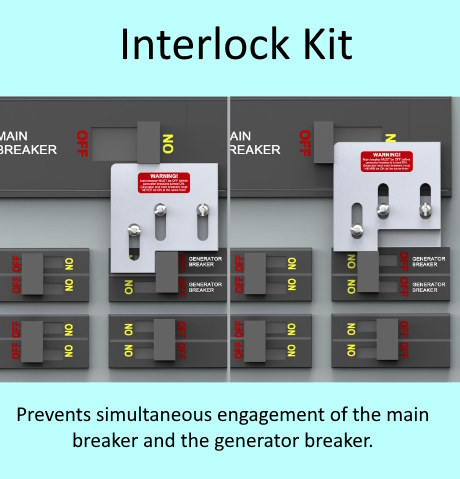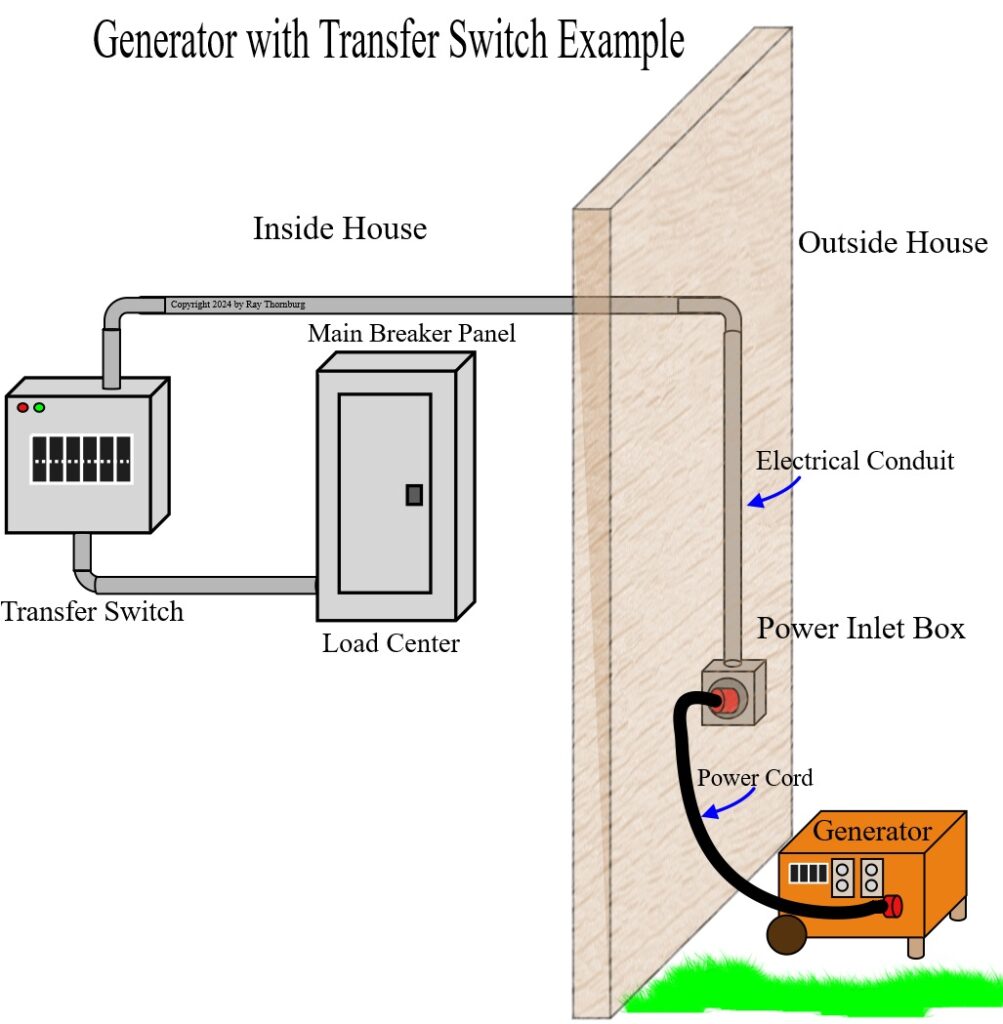As more and more homeowners are opting to add a generator to their home it’s time to discuss the different types of generators, how they’re used and how they should be installed. We’ll discuss the proper bonding and grounding along with some options for transfer switches. Let’s get started.
Two types of Generators
Basically there are two types of generators or rather two configurations you must know about.
- The Bonded Generator
- The Floating Neutral Generator
Study the Picture Below.
What Kind of Generator do I have?
While there may be a label somewhere on the generator; the best way to confirm this is to get an ohm meter and test for continuity between the grounding prong and the neutral prong of a 120 volt receptacle on the generator. If the tester shows continuity then it’s a bonded type. If it does not show continuity then it’s a floating neutral type.
If you’re just going to be plugging things into the generator using extension cords this may not be important to you. However, if you’re going to hook it up as a back up power solution then it’s crucial that you know before you begin your project. Also testing is important because the label may be incorrect or somebody may have changed the type by relocating the bonding jumper. Another reason is safety. It’s very important for generators to be connected correctly to prevent electrocution or circuit breakers needlessly flipping. I was surprised when I tested my portable generator.
The Bonded Generator
- The bonded generator is bonded (connected) between the neutral and the ground.
- Many older generators are the bonded type.
- Portable type OK to use “as is” with extension cords and portable equipment.
- Portable generators (both types) no ground rod is needed.
- If a bonded type generator is connected to the premise wiring then a transfer switch with a switched neutral must be used. Also a ground rod is required. This is because of these two rules-
- 1. Neutrals and grounding conductors can only be bonded together at one place in the home (at the first service disconnect).
- 2. Ground fault sensors must be downstream (on the load side) of the bonding connection.
So if a bonded generator was added it would violate those rules. To make it safe a switched neutral and it’s own ground rod is needed. This is what electricians call a Separately Derived System.
The Floating Neutral Generator
- Most newer generators are the floating neutral type.
- For portable applications the floating neutral generator is not as safe as a bonded generator because the fault current lacks an emergency return path.
- Floating neutral generators are well suited for connection to premise wiring.
- If a Floating Neutral Generator is used to connect to premise wiring through a transfer equipment then the neutral is not switched in the transfer equipment. Also no ground rod is needed.
- For certain portable applications it might be necessary to bond a Floating Neutral Generator. To do so buy a “ground to neutral bonding plug”. This can be inserted into one of the 120 volt receptacles. In certain circumstances this can solve issues with GFCI tripping or for use in charging RV’s or electric vehicles. It may also make using portable equipment using extension cords safer.
- Bonded Type Generator– You need a transfer switch with a switched neutral.
- Floating Neutral Generator– You need a transfer switch where the neutral is not switched.
Transfer switches must be designed to prevent the simultaneous connection of the generator to the electric utility power grid. There are many choices in transfer switches and some can be adapted for either type of generator. Some are automatic and some are manual. They can operate a few as one circuit and some are designed for many circuits or sometimes even the whole house depending on your budget and needs. Let’s start with the simplest first.
The Interlock Kit
The interlock kit– is a kit you buy from the panel manufacturer that installs on the main breaker panel. It’s a manual switch that prevents the simultaneous “on” position of the main breaker and the generator breaker. The generator is connected to a power inlet box which in turn is connected (back fed) to the breaker labeled generator in the panel. Generally a label is placed on the panel with instructions that go something like this.
- Turn off main breaker.
- Turn off all branch breakers.
- Slide interlock plate.
- Turn on generator breaker.
- Connect and start generator.
- Turn on essential circuits.
- Reverse this procedure to restore main power.
The big plus with the interlock type system is that you can choose which circuits you want to power. For instance if you want to turn several circuits off and let your water heater run for a while you can do this. Of course this takes a bit of knowledge in how electrical demand on the circuit breakers work and what your generator can handle.
The drawback is there are specific procedures to follow which an inexperienced member of your household may not understand. There’s also the possibly someone will be tempted to try to run more circuits than the generator can handle or the power cord was constructed to handle. Although in theory at least the breakers on the generator should be able to handle an overload condition. Probably in this type system the “essential circuits” should be clearly labeled in the panel to prevent an inexperienced person from flipping more breakers than needed and causing overload condition.
A system like this is probably the most inexpensive way to hook up emergency backup power.
Generator Safety- One of the most important things to remember is to put the generator completely outside to prevent deadly carbon monoxide poisoning from exhaust fumes. Do not put it at the entrance of your garage door but a suitable distance so to be safe from the fumes. Also the unit should be covered to prevent rain from getting on it in case it’s storming. So outside well away from the house and covered.
Transfer Switches
Transfer switches can be manual or automatic but both work in a similar way. The current in the conductor leading to the panel breaker is re-routed to the transfer switch and back to the panel breaker. The switch will not allow the simultaneous connection of the utility grid power with the generator power.
Manual Type Transfer Switch – When the power goes down you must walk to the switch and operate it. So there could be some lag in time to restore power when the utility goes down. Manual transfer switches are generally used with portable generators.
Advantages
- Less Expensive.
- Can be tailored for as few as one circuit or for all your critical circuits you choose.
- Less steps involved in the process or restoring power than an interlock kit.
- No special knowledge is required. Just start the generator and flip the switch.
Disadvantages
- Since you have to be there to flip the switch, a power outage that occurs when you’re away could be an issue for some people.
Automatic Transfer Switch – Automatically senses when the power goes off and starts the generator and restores power until the utility power comes back on. Used with permanently installed backup generators.
Advantages
- Easier to use, less steps involved.
- You must decide which circuits you want to include for emergency power when you install the system.
- The system can be designed for one or more circuits depending your needs.
- Larger transfer switches can serve multiple circuits each with it’s own switch so some flexibility is possible.
Disadvantages
- More expensive to buy and install.
Do you want to learn more about Grounding and Bonding? Visit our About Grounding and Bonding page.
Do you want to learn more about electrical panels, subpanels and local disconnects? Visit our About Panels, Subpanels and Local Disconnects page.





